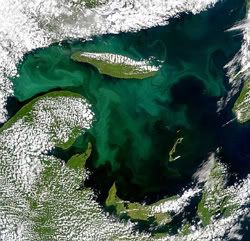 The Ocean Iron Fertilization (OIF) Controversy
The Ocean Iron Fertilization (OIF) ControversyAlgae, that wonder-plant that could be the biofuel of the future, could now also help solve the energy crunch problem from another angle: carbon sequestration. Simply put: there are many areas of ocean that have all the requisite elements for algae growth except iron. From time to time dust storms blow iron-rich soil into these oceans, just enough to satisfy the algae's 106:16:1:0.001 Carbon-Nitrogen-Phosphorous-Iron ratio, and huge algae blooms spring up (like the one pictured at right). This ratio means that for every atom of iron, 106,000 carbon atoms are bound into the algae. Or 83,000 pounds of CO2 for 1 pound of iron. The idea is that then 20-30% of the algae biomass sinks below the thermocline (100-200 meters) effectively sequestering the carbon from the atmosphere for hundreds of thousands of years.
I think the idea is a wonderful one in theory. But I would urge some caution when messing around with Mother Nature. A couple of anecdotes come to mind (although I'm sure you could find your own examples by throwing a rock in the air).
First is the story of saltcedar in New Mexico. In the early 20th century they brought in this non-native, deep-rooted species to solve the erosion problems they were having near the Pecos and Rio Grande rivers. The problem was that saltcedar was so successful, and so deep-rooted, that it spread like wildfire and began drinking the rivers dry. Now New Mexico spends millions of dollars a year in a near-futile effort to remove the plants and preserve water (if they're hard for nature to erode, then they're hard for us to remove).
Another story comes from my girlfriend's hometown of Medicine Lake, Montana. In the 30s and 40s they planted crested wheatgrass, a non-native prairie grass, in the Medicine Lake Wildlife Refuge thinking that it would provide a better shelter for wildlife. It proved too successful, growing so thick and so widespread that it's preventing wildlife from nesting there, opposite of the intended effect.
Maybe ocean iron fertilization would also prove too successful, pouring billions of tons of CO2 into the oceans and poisoning fish, replacing one set of problems with another.
In the next post I'll do the math to see whether it's worth exploring.


No comments:
Post a Comment